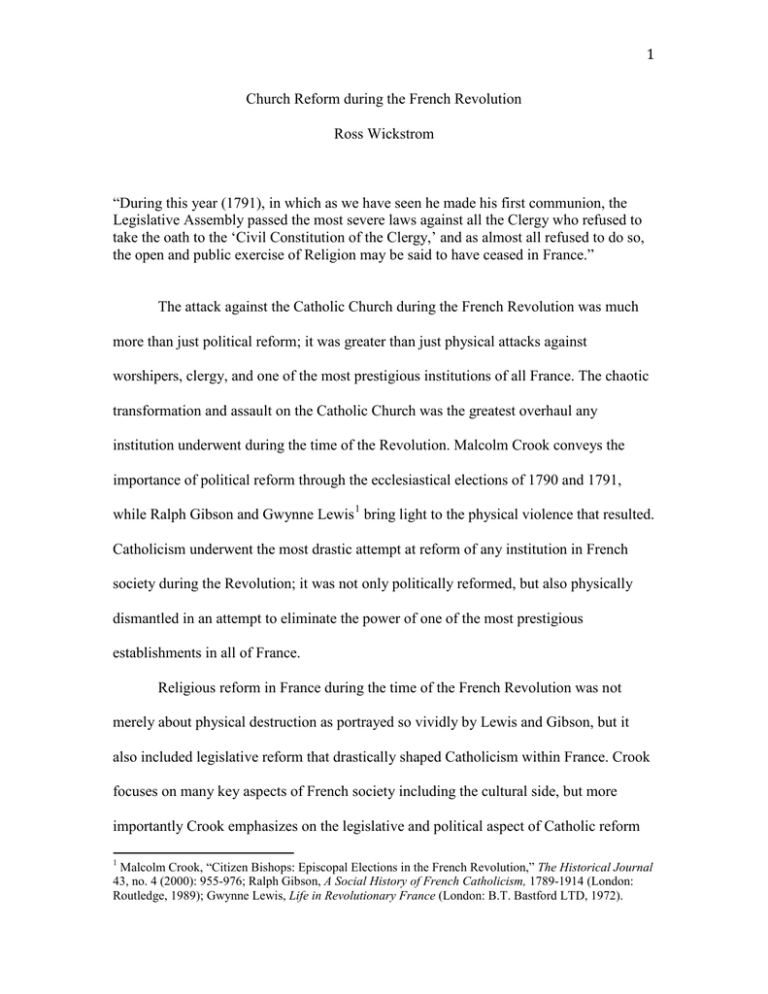1 Church Reform during the French Revolution Ross Wickstrom
advertisement

Church Reform during the French Revolution 1 Ross Wickstrom “During this year (1791), in which as we have seen he made his first communion, the Legislative Assembly passed the most severe laws against all the Clergy who refused to take the oath to the ‘Civil Constitution of the Clergy,’ and as almost all refused to do so, the open and public exercise of Religion may be said to have ceased in France.” The attack against the Catholic Church during the French Revolution was much more than just political reform; it was greater than just physical attacks against worshipers, clergy, and one of the most prestigious institutions of all France. The chaotic transformation and assault on the Catholic Church was the greatest overhaul any institution underwent during the time of the Revolution. Malcolm Crook conveys the importance of political reform through the ecclesiastical elections of 1790 and 1791, while Ralph Gibson and Gwynne Lewis 1 bring light to the physical violence that resulted. Catholicism underwent the most drastic attempt at reform of any institution in French society during the Revolution; it was not only politically reformed, but also physically dismantled in an attempt to eliminate the power of one of the most prestigious establishments in all of France. Religious reform in France during the time of the French Revolution was not merely about physical destruction as portrayed so vividly by Lewis and Gibson, but it also included legislative reform that drastically shaped Catholicism within France. Crook focuses on many key aspects of French society including the cultural side, but more importantly Crook emphasizes on the legislative and political aspect of Catholic reform 1 Malcolm Crook, “Citizen Bishops: Episcopal Elections in the French Revolution,” The Historical Journal 43, no. 4 (2000): 955-976; Ralph Gibson, A Social History of French Catholicism, 1789-1914 (London: Routledge, 1989); Gwynne Lewis, Life in Revolutionary France (London: B.T. Bastford LTD, 1972). through quantitative data assembled on the ecclesiastical elections of 1790 and 1791. 2 Crook argues that little to nothing is known about the constitutional clergy, nothing is known about the “citizen bishops,” and the ecclesiastical elections of 1790 and 1791 shine light on the lay people’s thoughts concerning the Civil Constitution of the Clergy. The “citizen bishops” were those who were elected by the French government, instead of appointed by the pope. Within Crook’s attempts to answer these basic arguments the aspect of legislative reform is addressed and understanding is brought to just how important political reform was. When addressing the legislative reform on Catholicism that took place during the French Revolution, it is important to understand the cultural aspect of politics; that is, those who are behind making these decisions and their influences. Crook’s work focuses on political reform and thus only pertains to males who owned land. However, Crook argues when concerning the election of the clergy it was truly an elite few making the decisions not the active citizens: “voters met in primary assemblies, in the cantons, to choose those second-degree electors, in proportion to the numbers entitled to vote (whether those active citizens actually took part or not). It was at the secondary level of the process, in the departmental and district electoral assemblies, that the clergy, like all national, departmental, and district official would be selected.” 2 The barriers an individual had to pass to become a member of the electoral colleges were quite difficult; as a result the “electoral colleges were composed of members of the wealthy elites from town and countryside, who enjoyed the time, money, and experience to spend several weeks a year fully engaged in political life.” 3 This new system of electing religious 2 3 Crook, Citizen Bishops, 957. Crook, Citizen Bishops, 959. 3 officials differed greatly from the previous system in which the power went from God, to the pope, to bishops, to priest. Power that was once in the hand of God was now in the hands of the French elite. This wealthy third estate political elite that was developing not only represented the political nature in which priest were elected, but the cultural phenomenon of those with wealth still maintained power. Despite this transfer of power, Crook argues the Catholic clergy still accepted the idea of reform, “but they were concerned that priests would be entirely excluded from the process.” 4 However, the clergy was not okay with the new diocese alignment in which “135 old-regime dioceses of various shapes and sizes were to be reduced to just eightythree, to conform to the new departmental administrative divisions.” 5 This downsize and the growing distaste from clergymen being completely eliminated from the election process resulted in ecclesiastical opposition to the Civil Constitution and caused the National Assembly to deliver an ultimatum to clergy. In this ultimatum, clergy had to swear their allegiance to the Civil Constitution or be replaced. The National Assembly believed that this would lead to more reform. Political reform was a key part of the transformation of Catholicism during the time of the Revolution. It created a divide that separated much of France for the remainder of the French Revolution. Political reform did not merely cause a divide, it also resulted in ill-informed and inexperienced people to be elected as religious officials: “no less than fifty-six of them had served as parish priest, while five were canons.” 6 Most importantly political reform set the foundation for physical chaos and a full out attack against Catholicism. 4 Crook, Citizen Bishops, 956. Crook, Citizen Bishops, 960. 6 Crook, Citizen Bishops, 973. 5 The physical attack on the Catholic Church was the focal point of Gibson and 4 Lewis’ work. Gibson argues that the French Revolution caused a break or pause in Catholicism, not a divide, while Lewis focuses on all aspects of society when portraying her account of the violence. Lewis takes into account both urban and rural, and the poor and the wealthy, as catalysts for violence. Both Lewis and Gibson use quantitative data. Lewis focuses his numerical data on the clergy and their earnings. Gibson uses maps and percentages to convey his argument. Lewis addresses both political and social aspects of Catholic reform while Gibson discusses France as a whole not, focusing on one particular region or class, though he does pay particular attention to Catholicism and its clergy. Gibson focuses on the cultural, political, and legislative aspect of Catholicism, and the violence that resulted. Lewis and Gibson collectively encompass the significant aspect of violence within Catholic reform. The Catholic Church was under reform, and as a result was no longer as powerful as it once was. Gibson acknowledges the political and legislative reformation of the Church, such as confiscation of land and the Civil Constitution of the Clergy, and uses these events to establish a foundation of why there were physical attacks on the Church. This is where Gibson begins to address the cultural aspect of Catholic reform; “the forms taken by dechristianization in late 1793 depended on individual initiative and local circumstances.” 7 This cultural aspect led to attacks on Catholicism, “churches themselves, and the impedimenta of Catholic worship, were physically attacked: the almost universal melting down of church bells for cannon and the confiscation of silverware to finance the war may have been merely measures of national defence, but the mutilation of statues, the breaking up of confessional boxes, and the physical closing 7 Gibson, A Social History, 43. 5 of churches themselves were clearly an attack on religion.” 8 This violence was not just an assault on the physical establishment of the church but on clergy as well, for “priests were cajoled, pressured, and threatened into abjuring their estates, perhaps 20,000 did so‘almost a general abdication of the active clergy’ especially if we include the large number who just quietly abandoned their priestly functions and never took them up again.” 9 Gibson argues it was this physical assault that led to the caesura in Catholicism during the French Revolution: “the vast majority of those who abdicated no doubt did so out of fear, but the result was nevertheless an almost total suspension of Catholic worship in France; by the spring of 1794, only perhaps 150 parishes in the whole country were publicly celebrating mass.” 10 The constant physical struggle that Catholics continuously dealt with not only caused tensions that divided a nation but caused Catholicism to come to a standstill in France. Lewis, in her portrayal of the violence, first establishes a foundation for why the Catholic Church was so fervently upset with the French Revolution and the reform. Lewis argues that religion was long under reform prior to the beginning of the French Revolution: “in 1789 there were only 1,700 religious houses in France, about half the number which existed in 1750. Louis XV had already expelled the Jesuits and seized some monastic property.” 11 Lewis also argues that the major cause of tension was from within the Catholic Church, for “the fundamental weakness of the Church…was the wide gulf which separated the higher from the lower clergy.” 12 This financial difference was vast: “the incumbent of the parish of Saint Eustache in Paris could count on an income of 8 Gibson, A Social History, 43. Gibson, A Social History, 43. 10 Gibson, A Social History, 44. 11 Lewis, Life in Revolutionary France, 38 12 Lewis, Life in Revolutionary France, 38. 9 6 10,000 livres a year. But for every one of these there were hundreds living on a minimum wage of 750 livres which hardly raised them, in economic terms, above the poorest members of the peasantry they served.” 13 This financial divide caused some of the First Estate to join the Third Estate in developing the National Assembly. The political focus continues into political reform in particular, assignats and their failure. Assignats were an attempt by the new government to sell land owned by the Catholic Church and hopefully assist in furthering reform; however the assignats failed and the optimism towards further reform ended. The Civil Constitution was another political reform that Lewis addresses: claiming that most of the clergy was willing to accept the Civil Constitution, because the salaries of the lower clergy would increase. However, it was not until the pope renounced the Civil Constitution that the clergy completely turned against it. Lewis connects the developing religious tensions to the social unrest that also existed at the time and argues religion was the last straw and resulted in a divided France filled with violence. The social tension between urban and rural society had reached its peak and the addition of religious division pushed rural citizens over the edge; “for the confused peasant the city-dweller was not only threatening his property but his God.” 14 This tension resulted in conflict:“in the summer of 1790 over 300 Catholics were killed by Protestants,” furthermore violence continued in the Vendean revolt of 1793. Violence, as a result of social tension, was just another element that religion influenced. The transformation that the Catholic Church underwent during the French Revolution was much more than just a physical attack against the Church or political reform. The assault the Catholic Church experienced consisted of many layers: political, 13 14 Lewis, Life in Revolutionary France, 38. Lewis, Life in Revolutionary France, 41. cultural, social, fiscal, and religious. All of these aspects played a role in the Catholic 7 reform and promoted violence. Lewis, Gibson, and Crook all make compelling and somewhat different arguments each addressing a different key aspect that produced reform. When these individual views are broadened and applied along with one another, an understanding of just how complex and vast the reformation of the Catholic Church was. The Catholic Church was once the most prominent and prestigious institutions in France and its downfall as a result of French Revolution was the most influential element of the French Revolution.



